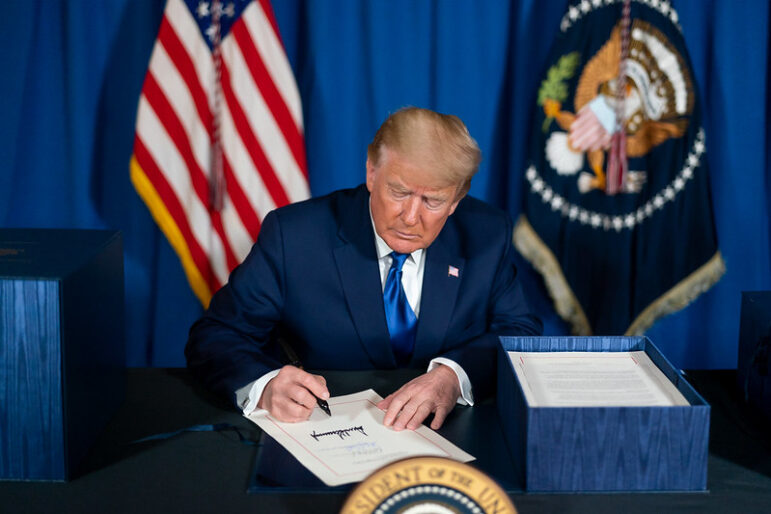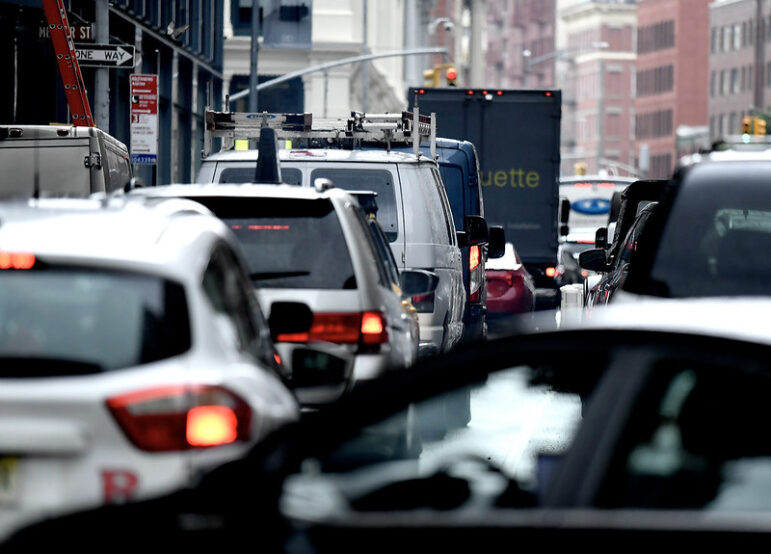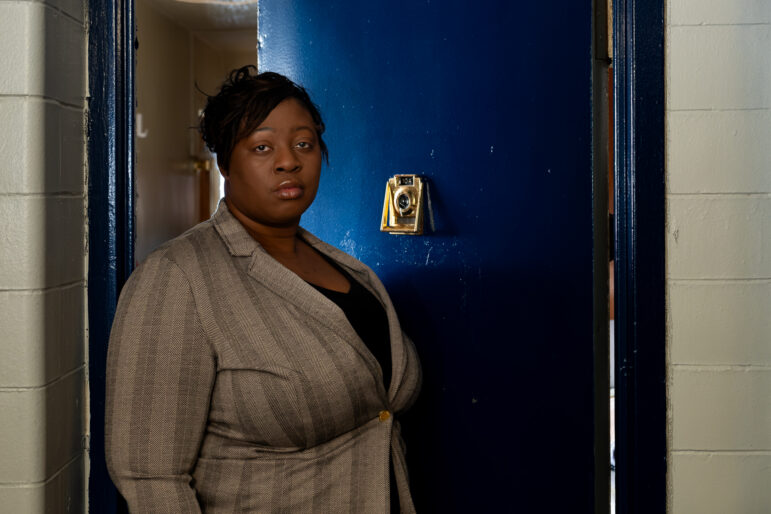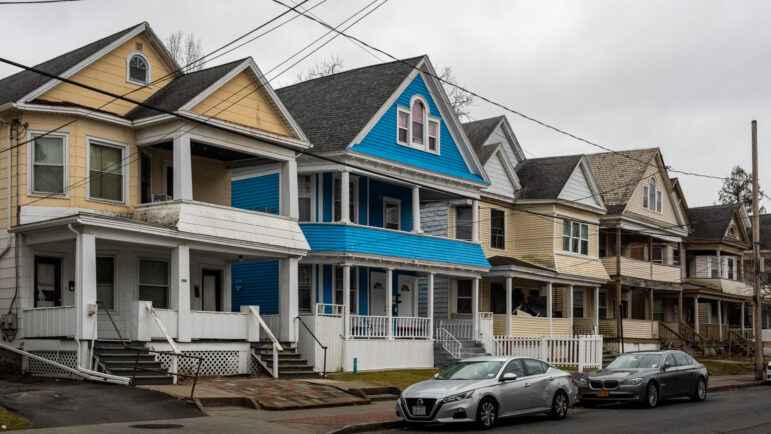
Adi Talwar
A scene from the recent Claremont Illuminated, a two-day photography festival designed to engage young people and artists in the South Bronx around public safety and community development
For six years, Laura Reynoso has set up a makeshift table on the sidewalk next to Corona Plaza and sold her handmade jewelry. The hundreds of bracelets, necklaces and charms she stitches and threads each morning are testaments to Corona’s vibrant local art scene.
Beginning in 2006, Queens Museum staff — including a full-time community organizer — met with individuals and local organizations to find out how the museum could best serve residents and artists like Reynoso.
During the discussions, various community members told the museum they wanted to revive Corona Plaza, an open space below the 103rd Street-Corona 7-Train station that had turned into a parking lot. In response, the Queens Museum and local organizations worked together with the Queens Economic Development Corporation to reclaim the area as a community and exhibition space. The plaza closed for further renovations in April 2017 as part of the Department of Transportation’s Plaza Program but will re-open this month with a slate of performances and exhibitions
“I’m happy because they said, ‘Let’s do something for Corona,'” Reynoso said, speaking in a mix of Spanish and English as a group of girls in dance costumes walked by. “We have venezolanos, ecuatorianos, haitianos, colombianos, dominicanos, blancos, negros, italianos. Everyone is here and now they’re thinking of us.”
Across the plaza, Julia Lemos, a resident of nearby Jamaica, held the chain link fence surrounding the plaza and peered at the concrete expanse. She says she would like to see similar museum-involved projects in other parts of the city.
“They can do more things like this for the public,” she says in Spanish. “They can make places for families to go, for children to go. It’s much more beautiful here now.”
Both Reynoso and Lemos say they do not visit museums because they do not have time, but they appreciate the Queens Museum and the Corona Plaza partners for bringing arts programming to them.
By meeting New Yorkers where they are, the Corona Plaza project exemplifies a broader, more inclusive concept of a museum that activists and artists from communities of color, low-income neighborhoods and other traditionally marginalized groups have championed for decades.
Museums are more than columned containers for static installations, says Antonio Serna, an artist and activist who runs the Alternative Economies Working Group, a program that explores ways to sustain artists from low-income communities.
Serna and many other local artists say museums — especially the 33 Cultural Institution Group (CIG) members located on city-owned property and receiving millions from the City — have a responsibility to listen to communities and meet the needs of people historically excluded from institutions.
“These communities are where culture comes from and there’s no reason to separate that,” Serna says. “And if they’re city institutions, then people should feel comfortable and empowered that they can go and use them.”
Last year’s ambitious CreateNYC Cultural Plan was designed to codify diversity, equity and inclusion efforts — CIG Chair John Calvelli says the 33 institutions will each complete diversity, equity and inclusion plans by Spring 2019. Already, CIGs serve an average of 258,500 school children at off-site programs each year, according to the Citywide CIG Data report.
But not all the CIGs approach community engagement equally, say activists like Serna, Monica Montgomery and Alicia Grullón, a Bronx-based artist and member of the People’s Cultural Plan, a manifesto crafted in response to the CreateNYC planning process and issues around the same time.
They say CIGs should serve as hubs for community organizing and nodes in a network that reaches into neighborhoods and meets individuals and families where they are most comfortable.
“Doing things within communities, centering communities and ensuring they are represented is what success looks like — that is the work of being a public-serving cultural organization and that is what we should be striving for,” says Montgomery, who co-founded Museum of Impact, a mobile museum focused on justice and equity in the arts, and Museum Hue, an organization that advocates for inclusiveness. “That allows for community folks to do workshops and art-making and really feel empowered to think ‘Hey, we’re comfortable here and we have a voice here.'”
Addressing inequities in the cultural sector
Nationwide, people of color make up just nine percent of museum visitors, according to a 2010 report by the American Association of Art Museum Directors. New York City museum staff also reflect racial and ethnic disparities. Though people of color make up 67 percent of New York City’s population, they occupy just 38 percent of cultural sector jobs, often in low-level roles, the city’s Department of Cultural Affairs (DCLA) reported in 2017.
Last July, after years of community engagement, the DCLA issued CreateNYC to address those inequities and to foster a sense of belonging among people traditionally excluded from the City’s museums.
CreateNYC acknowledges that a dominant Eurocentric curatorial focus and the historic exclusion of people of color, immigrants and low-income individuals have fueled the perception of art as a luxury and art institutions as designed for elite, predominantly white audiences.
The plan was structured into eight issues areas – including Equity and Inclusion, Affordability and Neighborhood Character – with each area encompassing various objectives and general strategies. These include creating “new supports for arts and cultural organizations with a primary mission of serving historically underrepresented/underserved communities” and halting “displacement by increasing access to long-term affordable workspace.”
Many entrenched and pervasive issues, such as access for people with disabilities and severe underrepresentation of people of color in museums’ administrative and board roles, informed the plan and galvanized artists around the city.
So too did the perspective that museums are more than just physical places, DCLA Commissioner Tom Finkelpearl said in a statement to City Limits.
“Viewing culture as an essential component of healthy communities is a cornerstone of the City’s CreateNYC cultural plan,” Finkelpearl said. “We are committed to supporting the efforts of NYC’s arts organizations to open their doors more widely, and to serve as community anchors – both within their walls and around the city.”
The Queens Museum model
Of all the CIGs, the Queens Museum, which Finkelpearl once directed, may most embrace a role beyond its building walls. The Museum’s efforts aim to enable people to overcome “Threshold Fear” — the experience of “walking by the door and saying, ‘Oh, that’s not for me,'” Montgomery says.
That sort of implicit barrier — the perception that art is a luxury for only elite, predominantly white audiences — often prevents people of color, immigrants and low-income individuals from visiting cultural institutions.
But sometimes, the barriers are physical.
The Grand Central Parkway, Long Island Expressway and the Van Wyck surround the Queens Museum in Flushing Meadows Corona Park and cut it off from nearby neighborhoods. That flawed urban planning forces the museum to proactively engage community members and bring them the programs they say they want, says Queens Museum Interim Director Debra Wimpfheimer.
“We have always worked with the intent to engage our community rather than to expect audiences to simply arrive on our doorstep,” Wimpfheimer says.
For example, she says, the Queens Museum hired a community organizer to assess community needs and partnered with organizations already on the ground.
Prerana Reddy, the former director of public events at Queens Museum, says the Queens Museum also used its own space to host immigrants’ rights initiatives and youth leadership programs that were “couched as a cultural experience.”
Reddy says the institution decided to create an entire department dedicated to community engagement rather than place community work under the umbrella of “education,” where she says staff typically lack the power to implement decisions and ideas.
“We wanted our neighbors to tell the museum what they want, not have the museum [dictating] the projects to the community,” says Reddy, who now serves as director of programs for Blade of Grass, which funds artists committed to social justice. “We wanted to build an ecosystem that connected various spaces.”
In addition to developing Corona Plaza, the museum partnered with Immigrant Movement International, a community center and think tank committed to art and activism. The project is based inside a shop on Roosevelt Avenue and was founded by artist Tania Bruguera in 2011.
Such community-centered programs serve as a bridge between individuals and the physical structures they help fund, Serna says.
“By funding the Immigrant Movement International art project, they allowed for community folks to do workshops and art-making and really feel empowered, to say ‘Hey we’re comfortable here and we have a voice here,'” Serna says. “Eventually, they’ll feel there’s no separation between them and the institution.”
Institutions like the Bronx Museum and Harlem’s Studio Museum, also use public spaces to reach into communities and create programs in response to community needs.
For the Studio Museum, community projects are essential to its existence. Its galleries are currently closed for renovations and the museum focuses instead on running its inHarlem program, a series of community-based arts events, like children’s workshops at New York Public Library branches, and installations, like large stick sculptures by Maren Hassinger in Marcus Garvey Park.
In addition to the CIG work, the DCLA allocates tens of millions of dollars to local, community-driven projects like Claremont Illuminated, a two-day photography festival designed to engage young people and artists in the South Bronx around public safety and community development.
A portion of the Claremont Illuminated funding came from the DCLA, which increased funding for cultural programs by more than $42.7 million to a total of $73.8 million for the 2019 fiscal year.
The 2019 budget allocates nearly $27.5 million to the Met, $5 million more than 15 other smaller institutions, including the Queens Museum and El Museo del Barrio, combined. Brooklyn Museum’s roughly $8.2 million in funding is nine times more than the Studio Museum’s roughly $918,000.
Despite their financial advantage, the city’s wealthiest art institutions fail to address barriers to access to the same extent as the smaller CIGs, says Grullón.
“Institutions like El Museo del Barrio and Studio Museum of Harlem work at engaging their immediate communities,” Grullon says. “These CIGS are the least-funded as compared with the Met.”
The Met does encourage social service agencies and camps to organize trips to the museum — “Visit The Met and make it yours!” its website states — and in June, the museum launched a “Civic Practice Partnership” residency program for two artists from Bedford-Stuyvesant and East Harlem with the stated goal of building bridges between the Met and underserved communities.
Grullon says those efforts are not sufficient for truly engaging communities and dismantling elitism, however.
“[Museums must be] actively involved in the community on the ground with grassroots organizers, funding them, giving them the space to organize free of charge,” Grullon said in an email. “[And by] holding open and frank discussions of cultural supremacist values and the real origin of museums’ place in society and how we can transform that.”
The desire to attract New York City’s 62.8 million tourists and its wealthiest residents can distract and discourage institutions from engaging local communities, Reddy says.
“[The Queens Museum] was freed in some ways because it’s not in a tourist location so there was no temptation to do shows that are mostly more attractive to tourists,” she says. “We don’t see that as our community.”
Montgomery says the Met in particular is “caught up in the tourist trap.”
“They are missing the world entirely by not thinking how they can stay relevant and be more diverse,” Montgomery says.”The Met is consumed with its Gala, its collections and what elitist curators want.”
“The Met is committed to working thoughtfully with partners throughout the city and within the Museum to develop programs and practices that encourage meaningful diversity among our staff and our more than seven million annual visitors,” the Museum said in a statement to City Limits.
Concerns about co-optation
For decades, community art has been co-opted by developers who aim to cater to wealthier residents, setting the stage for gentrification and displacement. Thus, institutions must be vigilant about how their community projects facilitate the displacement and inequity the CreateNYC Cultural Plan — along with countless artists and New York residents — aim to resist, says Gregory Sholette, an artist and CUNY professor.
“There are issues with the art world coming in and developing spaces that lead to displacement,” Sholette says. “So then the question is, who is it for?”
Because institution board members and wealthy funders so often overlap with the city’s developer class, there is a potential dark side to museum-initiated community projects, says Noah Fischer, a sculptor, writer and performer whose work addresses inequity.
“Museums are tied in with displacement and gentrification and creating cultural brands that attract certain kinds of people to neighborhoods,” Fischer says. “Our job [is] to ask who is really benefiting and who isn’t in a city pushing out its poor people.”
Jean Rice, a member of the board of directors for Picture the Homeless, offers one strategy for CIGs to better engage marginalized groups: “Hire homeless to work on big arts projects.”
There is precedent, Rice says. He pointed to structures crafted by freed slaves during Reconstruction and the large-scale public works projects built by crews of unstably housed people during the Great Depression as two examples.
“Those stories about how homeless people overcame impediments and obstacles could motivate the homeless today,” Rice says. “All too often their stories aren’t told.”
City Limits’ reporting on the intersection of art and policy is supported by the Laurie M. Tisch Illumination Fund. City Limits is solely responsible for all content.








